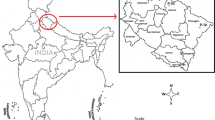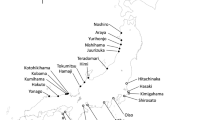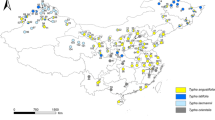Abstract
Hedeoma piperita Benth. is a perennial herb from the Lamiaceae family, which is highly valued for its medicinal and culinary properties by the Purépecha ethnic group in Michoacán, Mexico. The species presents populations of two morphotypes (white and purple corollas) that have not been formally studied. In this work, we aimed to evaluate the morphological and genetic variation between the two morphotypes. We sampled individuals from 15 populations within the Purépecha Plateau in western Mexico to measure 33 quantitative and qualitative morphological variable characters (vegetative and reproductive) and to estimate genetic diversity and structure using six nuclear microsatellite markers. Principal Component Analysis showed a clear separation between populations of the two morphotypes, which differences were statistically significant for all vegetative (n = 11) and reproductive (n = 22) characters. Similarly, Bayesian and multivariate cluster analyses based on the microsatellite data supported the distinction of the two morphotypes, except for one population of the white corolla that was genetically closer to the purple corolla group. Genetic diversity was moderate to low across populations of the two morphotypes, and inbreeding (FIS) was significantly higher in populations of the purple corolla. Our morphological and genetic data support the presence of two divergent morphotypes in H. piperita. This species is of high importance within the Purépecha culture, but unfortunately is declining in the region due to its high extraction rates. Thus, our results are valuable to delineate germplasm zones for future breeding programs and for informing in situ conservation strategies.



Similar content being viewed by others
Data availability
The datasets generated during and/or analyzed during the current study are available from the corresponding author.
References
Harley RM, Atkins S, Budantsev AL, Cantino PD, Conn BJ, Grayer R, Harley MM, De Kok RD, Krestovskaja TD, Morales R, Paton AJ (2004) Labiatae, In: Flowering plants·dicotyledons, Springer, Berlin, pp 167–275
Khoury M, Stien D, Eparvier V, Ouaini N, El Beyrouthy M (2016) Report on the medicinal use of eleven Lamiaceae species in Lebanon and rationalization of their antimicrobial potential by examination of the chemical composition and antimicrobial activity of their essential oils. Evid Based Complement Alternat Med. https://doi.org/10.1155/2016/2547169
Uritu CM, Mihai CT, Stanciu GD, Dodi G, Alexa-Stratulat T, Luca A et al (2018) Medicinal plants of the family Lamiaceae in pain therapy: a review. Pain Res Manag. https://doi.org/10.1155/2018/7801543
Aburjai T, Natsheh FM (2003) Plants used in cosmetics. Phytother Res 17:987–1000. https://doi.org/10.1002/ptr.1363
Carović-Stanko K, Marko P, Grdiša M, Jasna P, Dalibor B, Mirjana HĆ, Zlatko Š (2016) Medicinal plants of the family Lamiaceaeas functional foods: a review. Czech J Food Sci 34:377–390. https://doi.org/10.17221/504/2015-CJFS
Zamudio S, Bedolla-García BY (2013) Descubrimiento de Salvia buchananii (Lamiaceae) en estado silvestre en Querétaro México. Rev Mex Biodiv 84:530–535
Martínez-Gordillo M, Bedolla-García B, Cornejo-Tenorio G, Fragoso-Martínez I, García-Peña M, González-Gallegos R, Lara-Cabrera JG, Zamudio SI (2017) Lamiaceae de México. Bot Sci 95:780–806. https://doi.org/10.17129/botsci.1871
Cahill JP (2003) Ethnobotany of Chia, Salvia hispanica L. (Lamiaceae). Econ Bot 57:604–618. https://doi.org/10.1663/0013-0001(2003)057[0604:EOCSHL]2.0.CO;2
Viveros-Valdez E, Rivas-Morales C, Oranday-Cárdenas A, Castro-Garza J, Carranza-Rosales P (2010) Antiproliferative effect from the Mexican poleo (Hedeoma drummondii). J Med Food 13:740–742. https://doi.org/10.1089/jmf.2009.0041
Leyva-López N, Nair V, Bang WY, Cisneros-Zevallos L, Heredia JB (2016) Protective role of terpenes and polyphenols from three species of oregano (Lippia graveolens Lippia palmeri and Hedeoma patens) on the suppression of lipopolysaccharide-induced inflammation in RAW 264,7 macrophage cells. J Ethnopharmacol 187:302–312. https://doi.org/10.1016/j.jep.2016.04.051
Lara-Cabrera SI, Bedolla-García BY (2016) Diversidad de Lamiaceae en el Estado de Michoacán México. Acta Bot Mex 116:107–149
Bentham G. (1832–1836). Labiatarum genera et species. Ridgeway, London, 783 pp.
Irving RS (1980) The systematics of Hedeoma (Labiatae). Sida 8:218–295
Pascual CMM (2016) Fenología y Propagación en Huerto de la Planta Quiensabe (Hedeoma piperita Benth) en la comunidad de San Francisco Pichátaro Michoacán, Dissertation. Universidad Intercultural Indígena de Michoacán México.
Garibay OC, and Bocco VG (2011) Cambios de uso del suelo en la meseta Purépecha (1976-2005). INE-SEMARNAT CIGA, México, pp 124
Ceja HS (2017) Aspectos ecológicos y germinación in vitro de Hedeoma piperita, Benth, para su aprovechamiento sustentable en Cherán, Michoacán, México. Dissertation. Universidad Intercultural Indígena de Michoacán, México.
SAS Institute Inc (2014) JMP 11 scripting guide, 2nd edn. SAS Institute Inc, Cary
Segarra-Moragues JG, Gleiser G (2009) Isolation and characterisation of di and tri nucleotide microsatellite loci in Rosmarinus officinalis (Lamiaceae) using enriched genomic libraries. Con Genet 10:571–575. https://doi.org/10.1007/s10592-008-9572-7
Radosavljevi IĆ, Jakse J, Javornik B, Satovic Z, Liber Z (2011) New microsatellite markers for Salvia officinalis (Lamiaceae) and cross-amplification in closely related species. Am J Bot. https://doi.org/10.3732/ajb.1000462
Radosavljević I, Satovic Z, Jakse J et al (2012) Development of new microsatellite markers for Salvia officinalis L. and its potential use in conservation-genetic studies of narrow endemic Salvia brachyodon Vandas. Int J Mol Sci 13:12082–12093. https://doi.org/10.3390/ijms130912082
Karaca M, Ince AG, Aydin A, Ay ST (2013) Cross-genera transferable e-microsatellite markers for 12 genera of the Lamiaceae family. J Sci Food Agr 93:1869–1879. https://doi.org/10.1002/jsfa.5982
Raymond M, Rousset F (1995) GENEPOP (Version 1.2): population genetics software for exact tests and ecumenicism. J Hered 86:248–249
Chapuis MP, Estoup A (2007) Microsatellite null alleles and estimation of population differentiation. Mol Biol Evol 24:621–631
Peakall R, Smouse PE (2006) GENALEX 6: genetic analysis in excel, population genetic software for teaching and research. Mol Ecol Notes 6:288–295. https://doi.org/10.1093/bioinformatics/bts460
Kalinowski ST (2005) HP-RARE 10: a computer program for performing rarefaction on measures of allelic richness. Mol Ecol Notes 5:187–189. https://doi.org/10.1111/j.1471-8286.2004.00845.x
Pritchard JK, Stephens M, Donnelly P (2000) Inference of population structure using multilocus genotype data. Genetics 155:945–959
Earl DA, Vonholdt BM (2012) Structure harvester: a website and program for visualizing Structure output and implementing the Evanno method. Conserv Genet Res 4:359–361. https://doi.org/10.1007/s12686-011-9548-7
Evanno G, Regnaut S, Goudet J (2005) Detecting the number of clusters of individuals using the software structure: a simulation study. Mol Ecol 14:2611–2620. https://doi.org/10.1111/j.1365-294X.2005.02553.x
Jakobsson M, Rosenberg NA (2007) CLUMPP: a cluster matching and permutation program for dealing with label switching and multimodality in analysis of population structure. Bioinformatics 23:1801–1806. https://doi.org/10.1093/bioinformatics/btm233
Rosenberg NA (2004) DISTRUCT: a program for the graphical display of population structure. Mol Ecol Notes 4:137–138. https://doi.org/10.1046/j.1471-8286.2003.00566.x
Jombart T, Devillard S, Dufour A-B, Pontier D (2008) Revealing cryptic spatial patterns in genetic variability by a new multivariate method. Heredity 101:92–103. https://doi.org/10.1038/hdy.2008.34
R Core Team (2018) R: a language and environment for statistical computing. R Foundation for Statistical Computing, Vienna. https://www.R-proje ct.org
Excoffier L, Lischer H (2015) Arlequin 35 an integrated software package for population genetics data analysis swiss institute of bioinformatics. Evol Bioinform Online 1:1–47. https://doi.org/10.1177/117693430500100003
Dray S, Dufour A (2007) The ade4 package: implementing the duality diagram for ecologists. J Stat Softw 22:1–20. https://doi.org/10.18637/jss.v022.i04
Domínguez-Vázquez G, Berlin B, Castro-Ramírez AE, Estrada-Lugo EIJ (2002) Revisión de la diversidad y patrones de distribución de Labiatae en Chiapas. Anales del Instituto de Biología Serie Botánica 73:39–80
Corral-Bribiesca JI (2005) Variación morfológica y molecular de RAPD´s en Salvia polystachya (Lamiaceae). Bachelor Thesis. Facultad de Biología, Universidad Michoacana de San Nicolás de Hidalgo, Mexico, 68 pp.
Santillán-Ramírez MA, López-Villafranco ME, Aguilar-Rodríguez S, Aguilar-Contreras A (2008) Estudio etnobotánico arquitectura foliar y anatomía vegetativa de Agastache mexicana spp. mexicana y A. mexicana ssp. xolocotziana. Rev Mex Biodivers 79:513–524
Solouki M, Hoseini SB, Siahsar BA, Tavassoli A (2012) Genetic diversity in dill (Anethum graveolens L.) populations on the basis of morphological traits and molecular markers. Afr J Biotechnol 11:3649–3655. https://doi.org/10.5897/AJB11.2169
Thompson KA, Newmaster SG (2014) Molecular taxonomic tools provide more accurate estimates of species richness at less cost than traditional morphology-based taxonomic practices in a vegetation survey. Biodiv Con 23:1411–1424. https://doi.org/10.1007/s10531-014-0672-z
Heidari EF, Rahimmalek M, Mohammadi S, Ehtemam MH (2016) Genetic structure and diversity of ajowan (Trachyspermum ammi) populations based on molecular morphological markers and volatile oil content. Ind Crops Prod 92:186–196. https://doi.org/10.1016/j.indcrop.2016.08.014
Rico Y, Gútierrez-Becerill BA (2019) Species delimitation and genetic structure of two endemic Magnolia species (section Magnolia; Magnoliaceae) in Mexico. Genetica 147:57–68
González-Gallegos JG, Castro A, Quintero-Fuentes V, Mendoza-López ME, De Castro-Arce E (2016) Revisión taxonómica de Lamiaceae del occidente de México. Ibugana 7:3–345
Epps CW, Keyghobadi N (2015) Landscape genetics in a changing world: disentangling historical and contemporary influences and inferring change. Mol Ecol 24:6021–6040. https://doi.org/10.1111/mec.13454
Wester P, Claßen-Bockhoff R (2011) Pollination syndromes of New World Salvia species with special reference to bird pollination. Ann Missouri Bot 98:101–155. https://doi.org/10.3417/2007035
Wilson TC, Conn BJ, Henwood MJ (2017) Great expectations: correlations between pollinator assemblages and floral characters in Lamiaceae. Int J Plant Sci 178:170–187. https://doi.org/10.1086/690023
Kramer AT, Fant JB, Ashley MV (2011) Influences of landscape and pollinators on population genetic structure: examples from three Penstemon (Plantaginaceae) species in the Great Basin. Am J Bot 98:109–121. https://doi.org/10.3732/ajb.1000229
Whitlock R, Hipperson H, Thompson DBA, Butlin RK, Burke T (2016) Consequences of in-situ strategies for the conservation of plant genetic diversity. Biol Cons 203:134–142
Koohdar F, Sheidai M, Talebi SM, Noormohammadi Z (2015) Population genetic structure in medicinal plant Lallemantia iberica (Lamiaceae). Biodiversitas 16:139–144. https://doi.org/10.13057/biodiv/d160206
Pence VC, Winget GD, Lindsey KM, Plair BL, Charls SM (2009) In vitro propagation cryopreservation and genetic analysis of the endangered Hedeoma todsenii (Lamiaceae). Madroño 56:221–228. https://doi.org/10.3120/0024-9637-56.4.221
Fadhel NB, Boussaïd M (2004) Genetic diversity in wild Tunisian populations of Mentha pulegium L. (Lamiaceae). Genet Resour Crop Evol 51:309–321. https://doi.org/10.1023/B:GRES.0000024016.13743.8b
Yuan QJ, Zhang ZY, Hu J, Guo LP, Shao AJ, Huang LQ (2010) Impacts of recent cultivation on genetic diversity pattern of a medicinal plant Scutellaria baicalensis (Lamiaceae). BMC Genet 11:29. https://doi.org/10.1186/1471-2156-11-29
Mimura M, Aitken SN (2007) Increase selfing and decrease effective pollen donor number in peripheral relative to central populations of Picea sitchensis (Pinaceae). Am J Bot 94:991–998. https://doi.org/10.3732/ajb.94.6.991
Leimu R, Mutikainen P, Koricheva J, Fischer M (2006) How general and positive relationships between plant population size fitness and genetic variation? J Ecol 94:942–952. https://doi.org/10.1111/j.1365-2745.2006.01150.x
Auffret AG, Rico Y, Bullock JM, Hooftman DA, Pakeman R, Soons MB et al (2017) Plant functional connectivity–integrating landscape structure and effective dispersal. J Ecol 105:1648–1656
Acknowledgements
MLHA was supported by a postdoctoral fellowship by the Consejo Nacional de Ciencia y Tecnología (CONACYT). This work was supported by research funds to YR by Instituto de Ecología A.C. We thank to Antonio Tinoco-Ruiz for his assistance in field work and Luis Rey Flores Pérez for his assistance in editing figures.
Funding
Consejo Nacional de Ciencia y Tecnología (CONACYT) Posdoctoral Fellowship to MLHA. Research funds to YR by Instituto de Ecología A.C.
Author information
Authors and Affiliations
Contributions
Conceived and designed the work: all authors. Performed the field work and laboratory procedures: MLHA. Analyzed the data: MLHA, YR. Provided reagents and materials: YR, MLHA. Manuscript writing: YR, MLHA. Revised and approved the final version of the manuscript: all authors.
Corresponding authors
Ethics declarations
Conflicts of interest
The authors declare they have none competing interest.
Sample permit
SEMARNAT 09/N1-0011/04/18.
Additional information
Publisher's Note
Springer Nature remains neutral with regard to jurisdictional claims in published maps and institutional affiliations.
Electronic supplementary material
Below is the link to the electronic supplementary material.
Rights and permissions
About this article
Cite this article
Herrera-Arroyo, M.L., Rico, Y. & Bedolla-García, B.Y. Morphotype divergence and genetic diversity of Hedeoma piperita Benth. in western Mexico. Mol Biol Rep 47, 8925–8934 (2020). https://doi.org/10.1007/s11033-020-05946-x
Received:
Accepted:
Published:
Issue Date:
DOI: https://doi.org/10.1007/s11033-020-05946-x




